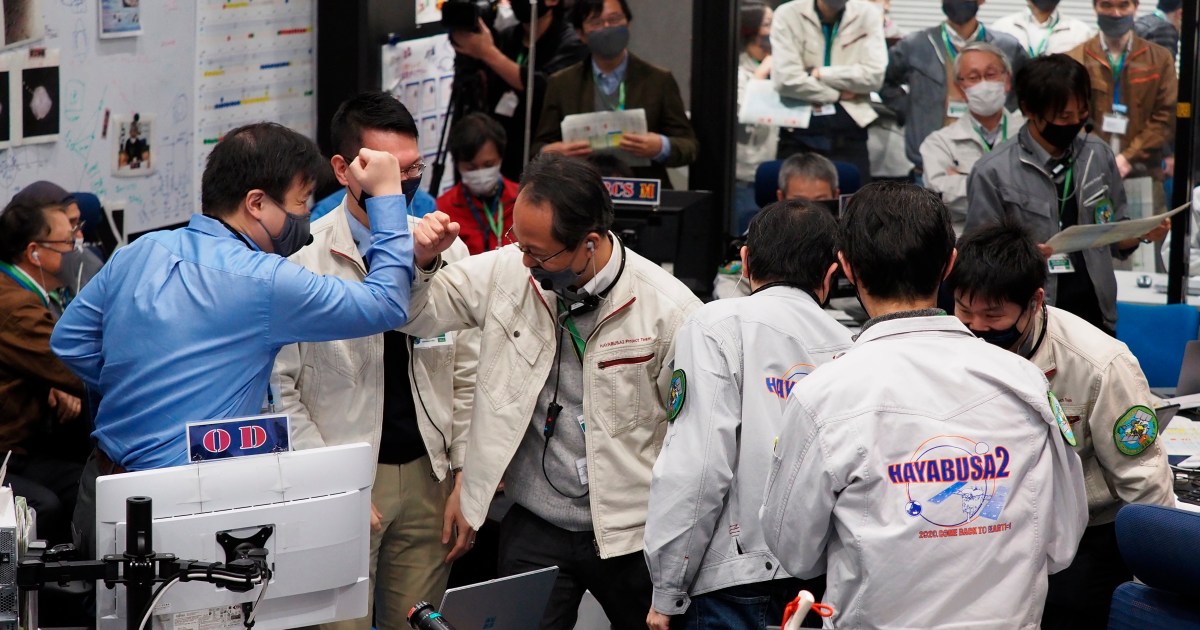Japan’s Hayabusa2 delivers rock samples from asteroid Ryugu | Australia
Japan’s space agency has retrieved a capsule carrying the first rock samples from beneath the surface of an asteroid that scientists say could provide clues to the origin of the solar system and life on our planet.
The spacecraft Hayabusa2 released the small capsule on Saturday and sent it towards Earth to deliver samples from the asteroid Ryugu, about 300 million kilometres (180 million miles), the Japan Aerospace Exploration Agency (JAXA) said.
“The capsule collection work at the landing site was completed,” the agency said in a tweet about four hours after the capsule landed.
“We practiced a lot for today … it ended safe.”
The return of the capsule with the world’s first asteroid subsurface samples comes weeks after NASA’s OSIRIS-REx spacecraft made a successful touch-and-go grab of surface samples from asteroid Bennu. China, meanwhile, announced this week its lunar lander collected underground samples and sealed them within the spacecraft for return to Earth, as space-developing nations compete in their missions.
打上げから6年間の宇宙の旅を経た「はやぶさ2」が持ち帰ったカプセルが無事に回収されたことを大変嬉しく思います。成功裡に導いたプロジェクトマネージャの津田教授をはじめ関係者の皆様に敬意を表するとともに、休む間もなく新たな探査に旅立った「はやぶさ2」の更なる活躍を期待します。#はやぶさ2 pic.twitter.com/RHiXyzZif1
— 首相官邸 (@kantei) December 5, 2020
Early on Sunday, the capsule briefly turned into a fireball as it re-entered the atmosphere 120 km (75 miles) above Earth.
At about 10 km (6 miles) above ground, a parachute was opened to slow its fall and beacon signals were transmitted to indicate its location.
“It was great … It was a beautiful fireball, and I was so impressed,” said JAXA’s Hayabusa2 project manager Yuichi Tsuda as he celebrated the successful capsule return and safe landing from a command centre in Sagamihara, near Tokyo.
“I’ve waited for this day for six years.”
The capsule descended from 220,000 km (136,700 miles) away after it was separated from Hayabusa2 in a challenging operation that required precision control.
About two hours after the capsule’s re-entry, JAXA said its helicopter search team found the capsule in the planned landing area in a remote, sparsely populated area of Woomera, Australia. The retrieval of the pan-shaped capsule, about 40 centimetres (15 inches) in diameter, was completed about two hours later.
JAXA officials said they hoped to conduct a preliminary safety inspection at an Australian lab and bring the capsule back to Japan early next week.
Samples are on their way for analysis at the Woomera Test Range. @haya2e_jaxa @AusAirForce @DeptDefence #Hayabusa2 https://t.co/eBIukNPTgu pic.twitter.com/AK0C7TCArk
— Australian Space Agency (@AusSpaceAgency) December 6, 2020
The material collected from the asteroid is believed to be unchanged since the time the universe was formed. Larger celestial bodies like Earth went through radical changes including heating and solidifying, changing the composition of the materials on their surface and below.
But “when it comes to smaller planets or smaller asteroids, these substances were not melted, and therefore it is believed that substances from 4.6 billion years ago are still there,” Makoto Yoshikawa, the mission manager, told reporters before the capsule arrived.
Scientists are especially keen to discover whether the samples contain organic matter, which could have helped seed life on Earth.
“We still don’t know the origin of life on Earth and through this Hayabusa-2 mission, if we are able to study and understand these organic materials from Ryugu, it could be that these organic materials were the source of life on Earth,” Yoshikawa said
Half the Hayabusa-2’s samples will be shared between JAXA, US space agency NASA and other international organisations and the rest kept for future study as advances are made in analytic technology.
 This computer graphics image released by JAXA shows the Hayabusa2 spacecraft above the asteroid Ryugu. [File: ISAS/JAXA via AP]
This computer graphics image released by JAXA shows the Hayabusa2 spacecraft above the asteroid Ryugu. [File: ISAS/JAXA via AP]For Hayabusa2, it is not the end of the mission it started in 2014. It is now heading to a small asteroid called 1998KY26 on a journey slated to take 10 years one way, for possible research including finding ways to prevent meteorites from hitting Earth.
So far, its mission has been fully successful. It touched down twice on Ryugu despite the asteroid’s extremely rocky surface, and successfully collected data and samples during the one and a half years it spent near Ryugu after arriving there in June 2018.
In its first touchdown in February 2019, it collected surface dust samples. In a more challenging mission in July that year, it collected underground samples from the asteroid for the first time in space history after landing in a crater that it created earlier by blasting the asteroid’s surface.
Asteroids, which orbit the sun but are much smaller than planets, are among the oldest objects in the solar system and therefore may help explain how Earth evolved.

